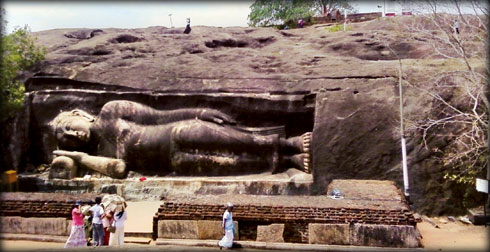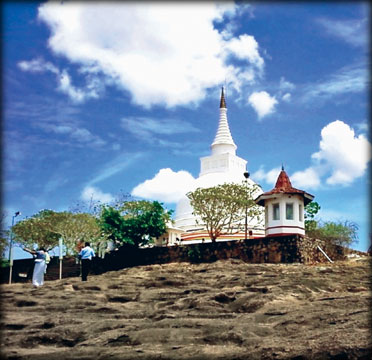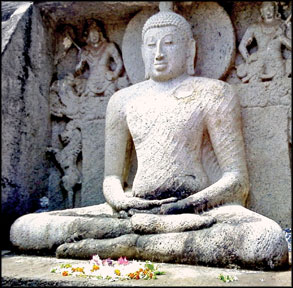Tantirimale - the sacred site of fascinating vistas and peaceful
serenity
by Ganga Ratnayake after a tour of Tantirimale
In the past, people went on pilgrimages in large groups. They would
wake up in the wee hours of the morning and prepare and pack meals for
everyone. They would also pack flowers for offering to the Buddha, in
hand-woven baskets. Clad in white, the pilgrims would set off in buses
to far away destinations, chanting pirith or singing Buddhist songs of
the good old days.
|

The reclining Buddha statue |
We too, a group of 10, comprising family and relatives, set off on a
pilgrimage recently, to a far away destination called Tantirimale.
After leaving Kandy, we passed through the cities and towns of Matale
- Dambulla - Kekirawa - Maradankadawala - Anuradhapura - Elayapattuwa -
Oyamaduwa and finally reached Tantirimale. It was 10.30 in the morning
when we stepped out of the van at Tantirimale Raja Maha Vihara.
The entrance of the temple was adorned with a tall pandal full of
relief motifs akin to lattice work. Right behind the pandal stood a
whitewashed monument surrounded by four punkalas (symbol of abundance).
After walking past the small shrine room with two Buddha statues, we
arrived in an open area with a view of the entire landscape unfurling
before us. It was a truly breathtaking spectacle where a seemingly
boundless rocky outcrop sprawled as far as our eyes could see,
transforming into rolling hills.
Enchanting landscape
The enchanting landscape of Tantirimale is encircled by Malwatu Oya
from the north and east, Wilpattu National Park from the west and
Mahawilachchiya Road from the south. The rocky outcrop spanning 250
acres is tucked in the midst of a dense jungle. As we stepped towards
the sloping hill, we saw the soaring bell tower glistening in white
against the deep blue of the sky, on the summit, next to the sacred Bo
tree.
The grey-toned landscape was speckled with white blots buzzing about,
as pilgrims clad in white from all corners of the island climbed up and
down the rolling hills. We followed them along a footpath to the summit.
The wind was gushing strong and hard as we arrived at the entrance of
the sandy courtyard surrounded by a stone parapet. This wall overlooked
a spellbinding panorama spreading as far as the horizon, with varying
shades of green turning into blue and converging into an indigo line.
Resting in the midst of a golden railing was the sacred Bo tree,
which boasts a long history. Following the advent of Arahat Mahinda
Thera in the third century BC, bringing Buddhism to Sri Lanka, Arahat
Sangamitta Theri was summoned to establish the Bhikkhuni Sasana (order
of Buddhist nuns).
|

The breathtaking scenery of Tantirimale |
|

The Samadhi statue |
Arahat Sangamitta Theri who arrived with a sapling from the Sacred Bo
Tree at Bodhgaya, India was welcomed by King Devanampiyatissa and was
escorted by a grand procession. En route to the city of Anuradhapura,
the procession stopped at Thiwakka Bamunugama (as Tantirimale was
known). The Bo sapling was placed on the summit of the highest hill in
Tantirimale and religious rites were conducted by the local ruler of the
area, Brahmin Thiwakka.
Later the sapling was taken to Mahamevna Uyana in Anuradhapura where
the planting took place amidst ceremonial rites. It is said that eight
saplings sprang from this Bo sapling, known as Ashta Pala Ruha, of which
one was bestowed to Brahmin Thiwakka. The Bo sapling was brought to
Tantirimale in a procession and was planted on the summit of the rocky
hill, where a sturdy stone parapet was built for its protection.
After performing religious rites, we slowly clambered down the
sloping terrain, took a detour and reached the foot of the hill from the
opposite side. Soon we came upon two fine relief statues – the giant
reclining Buddha statue and the big Samadhi Buddha statue, resting on
each corner.
The eight-foot tall Samadhi statue was flanked by stone pillars and
relief sculptures, flaunting the graceful craftsmanship of the olden
days. The 45-foot long reclining statue, soaring against the azure sky
painted with soft cirro-cumulus clouds, instilled us with reverential
admiration.
Rocky terrain
We turned around and proceeded uphill towards the other end where the
jagged rocky terrain led us this time to the Stupa of Tantirimale.
Surrounding the sandy courtyard of the stupa were several frangipani
trees facing all directions. From here, we descended the rock and came
upon a sandy path which took us to the big shrine hall some distance
away.
The shrine hall’s white facade was made of ornate pillars capped with
a dragon pandal which nestled a golden relief sculpture of Arahat
Sangamitta Theri bearing the sacred Bo sapling. The stairway leading to
the hall was flanked by the traditional guardian stones and the
semi-circular moonstone at its foot. The interior of the hall, from the
walls to the ceiling, was packed with vibrant motifs and murals
depicting tales from the Buddha’s life and the advent of the Sacred Bo
sapling. The finely crafted golden Buddha statue in the hall was also
surrounded by murals of deities and scenes of nature.
Iconic structures
The vast rocky landscape of Tantirimale Raja Maha Vihara not only had
these iconic structures, but was also replete with historical ruins of
great significance. Beyond the hills next to the scenic lotus pond was
the pothgula (library) of the olden days, with carved writings on the
rock, believed to date back to the eighth century. There were also caves
used by Bhikkhus of yesteryear, while some of these caves bore
prehistoric cave paintings.
During the day, the vast rocky outcrop turns blistering hot along
with the thin layer of sand that makes up the footpaths, yet the gushing
wind coming from all directions sweep the heat and sweat away. The
fatigue from climbing up and down the coarse grey terrain gets lost in
oblivion when surrounded by the enthralling panorama. Thus, Tantirimale
is not only a sacred site venerated by many, but is also a hub of the
finest craftsmanship surrounded by historical ruins and lush greens. |



